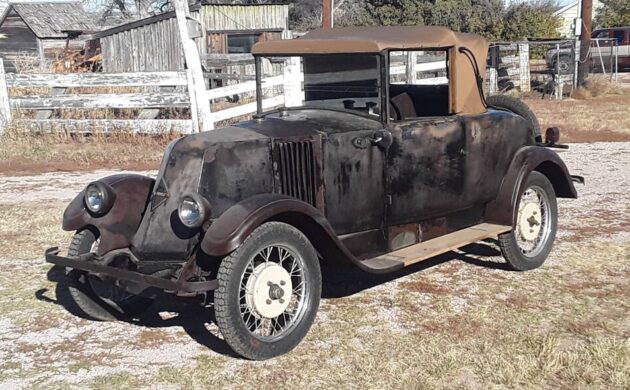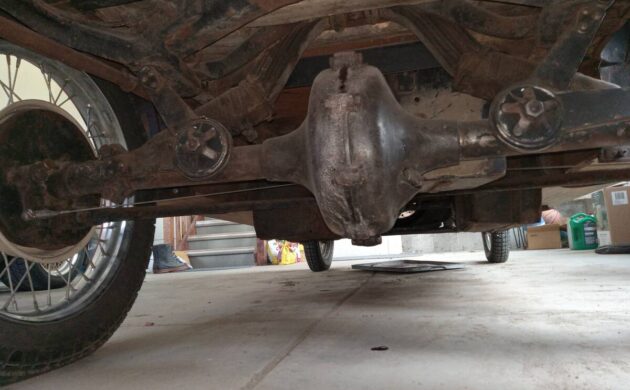Only One in the US? 1929 Renault RY1 Monastella Cabriolet
Louis Renault was every bit as mercurial as any Italian or American inventor that you care to name. With a reputation as a bellicose, domineering boss, Renault was the only French automaker whose factories were confiscated by the government and never restored to shareholders, including his family. He built his first car in 1898, the Voiturette. By the time he passed away in 1944, he had invented hydraulic shocks and drum brakes, and produced countless “voitures” of all shapes and sizes. Here on craigslist is one of the rarest of Renault’s production, a 1929 Monastella cabriolet. The asking price is $18,500, and the car is garaged in Elbert, Colorado. If you are very brave, you can drive it home! This car was formerly in Harrah’s Automobile Collection but was auctioned off as the collection was rationalized. We have Huff to thank for this très bien tip!
The Monastella was one of a line of “stella’s” – the Vivastella, the Primastella, the Suprastella, and several others. It was sold as a car for the ladies, being the smallest of the bunch. Factory-supplied with a 1474 cc inline six-cylinder, this car must have had an engine transplant at some point despite the seller’s claim that the drivetrain has never been apart, as it is currently sporting a four-cylinder. Here is what the engine should look like, derived from this restoration journal involving an RY3; note that the RY3 wears its radiator conventionally, in front – thus the shovel nose has grille slats. Our subject car is an RY1, with the radiator behind the motor and vertical louvers down the sides of the hood. Its original gearbox was a three-speed manual. The Monastella apparently had a reputation for poor handling thanks to its transverse leaf rear suspension; furthermore, it was underpowered given its heft. Production ended in 1932.
The seller notes that both the canvas top and the interior have been restored. This car has a rumble seat mounted on graceful hinges and upholstered in the same brown vinyl as the cockpit. Speaking of the interior, the photo supplied by the seller was profoundly unrevealing, so we dug up another image that more effectively shows off its intricacies.
The underside is clean enough with this shot showing off the chromed wire wheels. The seller says the tires are new. Mechanical brakes serve all four wheels, and interestingly, this pre-war Renault was factory-supplied as a 12-volt. The cabriolet version of the Monastella (the model came in several body styles) was apparently crafted by Mauguy, a little-known French coachbuilder. I always wonder how owners of rare cars such as this one arrive at a price. In this case, I was able to find another Monastella for sale, though I have no confidence in the recency of this ad. What will it take for this French rarity to find a home?







Comments
It would make a great oddball street rod
Are you sure that the radiator’s at the front? There’s the photo showing the engine with the radiator and its mounting frame, which also shows the curve of the front wing (looks like the section that joins the running board). The shot looking forwards from beside the back of the car doesn’t show a frame at the front. I know that Renault stuck with the rear radiator / coal scuttle bonnet for long after the rest had moved to front-mounted radiators.
Interesting bolide; a fairly rare beastie here too.
The radiator of the RY3 was supposed to be at the front, the radiator in an RY1 – this car – is supposed to be next to the firewall between the engine bay and cockpit, thus the louvers on the hood and not the nose.
Hi Michelle,,,I was fascinated by the reason American truck makers used rear mounted radiators in their early trucks. Mack, International and Kelly-Springfield used them , it’s believed the radiator was protected from anti-truck lobbyists that would try and damage the truck. Apparently, there was a big movement in the teens where horsey folks still thought machines were evil. Also, since the trucks speeds were so slow, it was deemed better to push the air rather than pull it. Some dozers do the same thing. Not sure Renaults intent, anyone?
Saw this car in Harrah’s collection in Reno in the early ’70s. Looked a bit better than it does now. Obviously not stored properly since the collection was sold off. Renault has always been an odd ball manufacturer but the forward thinking in designing the mechanicals and bodywork has always been there and always innovative.
Imagine how tough it will be to find parts. Yikes.
I like most of the old cars, but not this one… ugly is the best description. I’ve never been much of a fan for Renault either.
I’ve seen prettier mud fences.
The part that throws me off is the wedge shaped solid front end, where one would expect to see a grill (and a radiator).Even in the air cooled Franklins have a phony cowl! Perhaps Mr. Renault was thinking the interior would be easier to keep warm with the radiator against the firewall? Anyway, you can rest assured yours would be the only one at Cars and Coffee. Sacre bleu!
Major oddball. Would like to hear how it ever got to Elbert, out on the plains southeast of Denver. Those look like motorcycle wheels with spokes going right into the brake drums!
Bill Harrah had no problem buying a car in Europe if he liked it and wanted to add the car to his collection. When the Harrah collection in Nevada was broken up in a series of auctions, whoever bought it may have lived in Elbert.
junk
The wheels appear to be from a Ford Model A. And possible other undercarriage bits too.
In any case, not the original Renault wheels that were plain stamped steel discs.
I do not think that this is a Monastella but more likely a Renault KZ. The Monastella is a 6 cyl car and looks different. This has the nose of a KZ. Should also note that the wheels are most likely from model A
Exact, this car is a 1924 “KZ”, and has absolutely nothing to do with any of the “Stella” series that are far newer designs beginning in 1930.
And all these Renault cars had disc wheels, never wire wheels. In fact, no Renault car after 1902 ever had wire wheels. They only had wire wheels from 1898 to 1901, after which they used wooden spoke wheels, then after WW1, steel disc wheels.